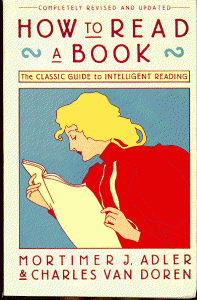This is the first and most important assignment for each of my classes, in every term. It will not hurt you to repeat this assignment, because each time that you complete it you will learn something new about your skills at reading and comprehending texts.
The specific points and due dates for this assignment are posted in your course Canvas site, Module 3. The sources for each class are the same.
One reason for this assignment is that you will use sources for this class differently from most other history classes: no memorization and testing, but rather a review of different events, taking notes, and then summation of what you have learned from these by means of short essays or reports.
Once you have completed reading and viewing these three sources, you will post your comments in the special course Discussion Board (DB 1) in your Canvas site for this assignment.
Here are the sources, three films and one short article:
- FILM How to Read a Book You Don’t Want to Read. By Jim Trelease. Visit his web page Trelease on Reading.
2. ARTICLE How To Read a Book Click on the link to access the PDF copy of the article.
3. FILMS Two films by Rita Carter –
- Why Reading Matters (2018) TEDxCluj
- Why Reading Matters (2009)
Whoever owns the rights to Rita Carter’s extended documentary film (2009) are really being jerks; I think it is the BBC. They take down YouTube versions on a regular basis, but have NOT created a DVD available to the general public.
However, now (January 2021) there are more versions (six) of the same documentary that have been posted on You Tube.
Plus Palomar College Library also has a link to the complete film below. This requires a log in by Palomar students and faculty.
Watch the short version (2018) first, and then watch as much of the extended documentary (2009) as you can.
2018 version
Rita Carter has a recent (2018) TEDx presentation where she discusses an abridged version of the important of reading fiction.
2009 version
Here is a link to various segments of the extended documentary still available at You Tube:
When Part 1 ends, click on the link to YouTube in the upper left hand corner to continue with the film.
Palomar students and faculty can view this full documentary through our Library subscription to Films on Demand, which involves a log-in, the same as students use to access eServices:
How modern neuroscience has revealed that reading unlocks remarkable powers in people.
Science writer Rita Carter tells the story of how modern neurosciences have revealed that reading, something most of us take for granted, unlocks remarkable powers.
Carter explains how the classic novel Wuthering Heights allows us to step inside other minds and understand the world from different points of view, and she wonders whether the new digital revolution could threaten the values of classic reading.
These sources will get started early on your first assignment for my course.
Next you will post your comments in your Canvas site, in DB 1.
MORE ON “HOW TO READ A BOOK”
When you have the time, I recommend that you take a look at these other sources. These are not required, but you should find them useful:
 Yes, there actually is a book titled How to Read A Book, and it has been in print since it was first published in 1940. This link above is to the Wikipedia page on the history behind this book.
Yes, there actually is a book titled How to Read A Book, and it has been in print since it was first published in 1940. This link above is to the Wikipedia page on the history behind this book.
This book is how I was introduced to the concepts presented in the first two sources for this assignment, back when I was in graduate school at UC San Diego.
Every library in San Diego has a copy of this book, if you are interested. Here is the page for this book at Amazon.
Recommendations for Reading the Course Books
When reading any books in this course, such as American Nations, The Unredeemed Captive, The Korean War, or 1493, remember that you should read through these rather quickly THE FIRST TIME for the general themes and issues they present.
Do not become slowed down by a concern for names and dates as you will not be tested on these. Names and dates ARE important, but only as part of the larger picture of a history.
You should always be asking yourself:
- What are the major themes, personalities, and events in the course sources?
- How do smaller pieces of the story illustrate the larger topics?
Learn to skim through a first reading, taking down brief notes at the end of the first reading, and then later go back and re-read the text to confirm the major issues, events, and personalities, and to expand your notes.
Always ask yourself:
- When and where does this story occur?
- Who are the main characters in the story?
- What is the main point the author is attempting to make with this story?
Finally – Dig for More!
If there is a topic that really interests you, dig for more information on it. Do some online research, ask Dr. A or a librarian for help on finding more information on the topic that interests you.
Remember, anyone can be a writer, a historian, a poet. Help us help you develop the tools that you need to write what really interests you.
Check out the services available to you at the following important places on campus:
- Palomar College Library – Research Help
- Palomar College Reading Services Department
- Palomar College Writing Center
